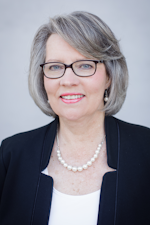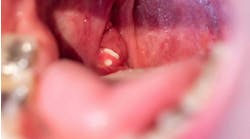My name is Janet, and I am not a cancer survivor. I’m sharing my story with the hope that you as dental professionals will be ever diligent in doing those important intraoral and extraoral cancer exams on all of your patients. It’s too late for me, but it’s not too late for your patients.
About eight years ago, a painful red bump developed on the side of my tongue. When I went in for my cleaning, the hygienist did not mention it. I guess she didn’t see it, since she didn’t say anything to the doctor about it. When the dentist came in to do the exam, I showed him the bump. He asked me how long it had been there, and I told him it had appeared about a month earlier. So, he referred me to an oral surgeon to have it biopsied. Understandably, I was worried, because I had a long history of smoking. I knew smoking was associated with oral cancer, but I was very healthy otherwise. Besides, people get all kinds of little bumps and blisters in their mouths, right?
I was relieved and so happy when the biopsy came back negative. All that worrying I did was for nothing. But still, I decided to quit smoking.
Then, six years later, the painful lesion came back. I went in to see my dentist again, and he insisted that there was nothing to worry about, since “cancer doesn’t get sore.” The lesion came and went. It became a worrisome annoyance, especially because my tongue felt sore so often. More than once, I accidently bit it while trying to chew my food. I got so tired of my tongue being sore that I made an appointment for another biopsy.
Well, guess what? This biopsy came back positive for squamous cell carcinoma. Keep in mind that six years had passed since the first negative biopsy.
I was referred to an otolaryngologist for surgery. He removed the lesion along with a large chunk of my tongue. The PET scan indicated no lymph glands were involved. The attending radiologist did not feel radiation would be needed. This was in February.
The end of October arrived, and so did the cancer. Another PET scan showed cancer along the jawline. Of the 27 lymph nodes that were removed, five were cancerous. The doctor recommended preventive radiation and chemotherapy. This was the beginning of the end for me.
I was scheduled for one day each week for chemo and five days a week for radiation for five minutes. The doctors were so encouraging, even to the point of giving me a “100% chance” for successful eradication of the oral/throat cancer. But I had no idea how terrible radiation and chemo were going to be. The radiation burned a nonhealing hole (they called it “tissue necrosis”) in my neck, and the chemo made me deathly sick. The inside of my mouth looked like someone had poured scalding hot water in my mouth over and over again. I became unable to swallow, so I was given a feeding tube. It was worse than anyone’s worst nightmare.
Unfortunately, the cancer persisted after the radiation and chemo were completed. There were more doctors and more attempts with other therapies. I had several hyperbaric oxygen treatments to try to encourage healing of my neck, but it did not work. I was also enrolled in a trial using immunotherapy, but it made me so sick that the therapy had to be stopped. My life was filled with pain, infections, and drugs.
Of course, this roller-coaster ride of hope and defeat took a terrible toll on my family. I could not have endured any of this without them by my side, all the way to the end when I took my final breath.
That’s my story, but why am I sharing this with you? My thoughts go back to the very beginning and that day in the dental chair when the hygienist who saw me did not mention the lesion. I can only assume she didn’t see it. She did not take a gauze and pull out my tongue to look for anything unusual, nor did she feel my neck or examine my throat area. Don’t hygienists have a responsibility to do oral cancer exams? Wouldn’t it have been right for her to call the lesion to the doctor’s attention instead of me having to do that? It really disturbs me that she spent 45 minutes in my mouth and never saw the lesion. If she had looked, I don’t think she could have missed it.
Another thing that bothers me is the fact that no one seemed concerned that the annoying lesion kept coming back. Since the first biopsy was negative, I had this false sense of security. Nobody wants to think they have cancer. But when a test is negative, and the lesion keeps coming back, shouldn’t that raise a red flag? Looking back, I now see that there was too much time in between biopsies. If my cancer had been diagnosed earlier, I might still be alive.
Please understand, I’m not trying to blame anyone for my death. However, I do feel that dental hygienists and dentists are uniquely educated to identify abnormalities in their patients’ mouths. That’s not going to happen if they are not diligent about oral cancer exams. After all, you won’t find the problem if you’re not looking for it. I hope that all dental hygienists and dentists will realize that performing oral cancer exams—both intraoral and extraoral—is one of their most important duties. I think it’s easy for hygienists to focus on cleaning teeth and dentists to focus on fixing teeth. While those tasks are important, nothing is more important than saving a life.
Resource
OCF oral cancer screening. YouTube. October 16, 2014. https://www.youtube.com/watch?v=jLzOgTlKWgs&t=238s
DIANNE GLASSCOE WATTERSON, MBA, RDH, is a consultant, speaker, and author. She helps good practices become better through practical analysis and teleconsulting. Visit her website at wattersonspeaks.com. For consulting or speaking inquiries, contact her at [email protected] or call (336) 472-3515.







